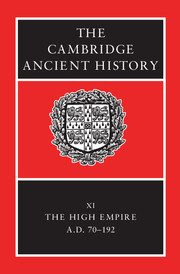Book contents
- Frontmatter
- PART I NARRATIVE
- PART II GOVERNMENT AND CIVIL ADMINISTRATION
- PART III THE EMPIRE
- PART IV ROME, ITALY AND THE PROVINCES
- 12 Rome and Italy
- 13 Spain
- 14 Gaul
- 15 Roman Germany
- 16 Africa
- 17 Cyrenaica
- 18 Britain
- 19 The Danube provinces
- 20 Greece and Asia Minor
- 21 Syria and Arabia
- 22 Judaea
- PART Va ECONOMY AND SOCIETY
- PART Vb ART AND CULTURE
- Chronological Table
- BIBLIOGRAPHY
- Index
- 1 The Roman world in the time of Marcus Aurelius
- 7 The Danube provinces
- References
15 - Roman Germany
from PART IV - ROME, ITALY AND THE PROVINCES
Published online by Cambridge University Press: 28 March 2008
- Frontmatter
- PART I NARRATIVE
- PART II GOVERNMENT AND CIVIL ADMINISTRATION
- PART III THE EMPIRE
- PART IV ROME, ITALY AND THE PROVINCES
- 12 Rome and Italy
- 13 Spain
- 14 Gaul
- 15 Roman Germany
- 16 Africa
- 17 Cyrenaica
- 18 Britain
- 19 The Danube provinces
- 20 Greece and Asia Minor
- 21 Syria and Arabia
- 22 Judaea
- PART Va ECONOMY AND SOCIETY
- PART Vb ART AND CULTURE
- Chronological Table
- BIBLIOGRAPHY
- Index
- 1 The Roman world in the time of Marcus Aurelius
- 7 The Danube provinces
- References
Summary
We describe as Roman Germany the two forward zones which Augustus established on the Rhine for action against the tribes between the Weser and the Elbe. There were two high commands here invested with imperium, one for the ‘upper army’ (Exercitus Germanicus Superior) in Mainz, the other for the ‘lower army’ (Exercitus Germanicus Inferior) in Cologne.
The end of the Batavian revolt (a.d 68–70) also marks the end of the keen attention which Roman imperial historians had paid to Germania up to that point. Under Augustus the princes of the imperial family had imperium maius and waged war in Germania. Claudius still showed great interest in the new military enclaves in the context of his Gallic policy and the exploitation of natural resources. He had begun the process of municipalization with the raising of Cologne to colonial status and he, or Nero, had perhaps established a municipium with the name Cibernodurum out of the tribal centre of the lower Rhine Ciberni or Cuberni. The military activity on the Rhine between 13 b.c and a.d. 70 is characterized by the presence of fourteen legions between the Alps and the Dutch coast. At this epoch the history of Roman Germany is essentially imperial history.
With the end of the Batavian revolt Germania vanished from the purview of imperial politics. The legions on the Rhine were already reduced to six by a.d. 43 for the offensive against Britain. After the rebellion of the Rhenish tribes four legions (I, IV, XV and XVI) were broken up.
Keywords
- Type
- Chapter
- Information
- The Cambridge Ancient History , pp. 496 - 513Publisher: Cambridge University PressPrint publication year: 2000
References
- 2
- Cited by

